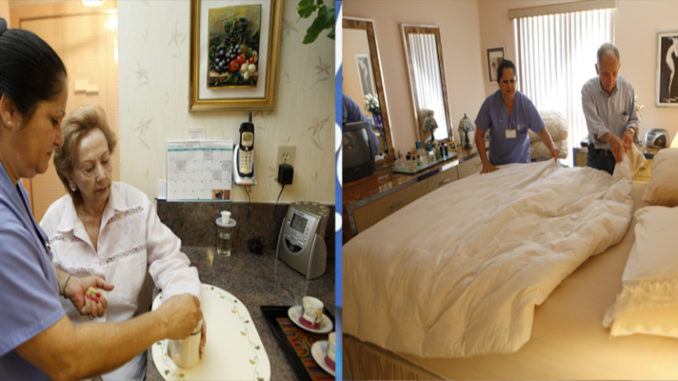
by Ted Hesson
We’re going to need a lot more home health workers in the future. Guess where they come from?
One of the biggest future crises in U.S. health care is about to collide with the hottest political issue of the Trump era: immigration.
As the largest generation in American history – the baby boom – heads into retirement and old age, most of those aging boomers will need someone to help take care of them for at least some portion of their twilight years. Demand for home health aides is expected to outstrip the growth for nearly all other jobs in coming decades, with the Bureau of Labor Statistics projecting the number of home health aide positions will increase 38 percent by 2024. That puts it among the top five fastest-growing U.S. occupations.
So who’s going to do it? The question is one of the biggest uncertainties looming over not only the health care, but the labor market overall. Health policy experts have been raising the alarm for some time: No matter how you look at it, the United States is going to need a lot more caretakers and home health aides. And we’re going to need them soon.
Right now, immigrant workers fill a significant share of the formal and informal caretaker workforce. In health care overall, immigrants (both legal and undocumented) make up roughly 17 percent of workers, on par with their representation in the broader labor force. When it comes to home health care, however, that figure is considerably higher: about 24 percent, according to the nonpartisan Migration Policy Institute.
There’s a reason foreign-born workers take so many home health jobs: they’re low-paid, low-skilled and increasingly plentiful. Barriers to entry are low; a high school degree is not usually a requirement and neither is previous work experience. Much caretaking comes from family members, of course. But with families getting smaller, more Americans living alone and chronic diseases growing more complex, a lot of that care in the future will need to come from professionals.
The job also isn’t easy. Home health aides can be tasked with bathing and feeding clients, cleaning the person’s house, driving them to doctor’s appointments and even helping with trips to the bathroom. It’s one of those occupations that comes to mind “when people say that immigrants do the jobs that Americans don’t want to do,” notes Patricia Cortés, an assistant professor of markets, public policy and law at Boston University’s Questrom School of Business.
Bianca Frogner, an associate professor at the University of Washington School of Medicine, said the low barriers to entry make it a natural fit for immigrants who are new to the U.S. workforce. “It’s easy to get into and they’re in high demand,” she said.
This is where politics comes in: The current move to curb immigration threatens to cut off the main supply of potential new workers to care for aging Americans.
Illegal immigration isn’t the issue. The home health care immigrant workforce is vastly legal. The Pew Research Center found that just 4 percent of nursing, psychiatric and home health aides are in the country without legal status, based on an average from 2005 to 2014. Some home health aide positions require certification, which may drive down the ranks of undocumented immigrants in those positions.
The question for the health care system is what will happen to the flow of legal immigrants. Trump and immigration hawks in Congress have endorsed a bill that would cut legal immigration in half over a decade. The bill would also refocus the immigration system to prize better-educated and more highly skilled immigrants — potentially choking off the supply of lower-skilled workers who are the likeliest candidates to fill the home health aide jobs of the future.
In theory, native-born Americans could take some of those jobs, but there are reasons to assume they won’t.
One reason is salary. The average annual wage for a home health aide is $23,300, according 2015 census data analyzed by the University of Washington Center for Health Workforce Studies. The average salary for personal and home care aides (a lesser-skilled position) is even lower, just $15,800 per year.
Joanne Spetz, director of the Health Workforce Research Center on Long-Term Care at the University of California, San Francisco, says there are reasons the job is low-paid. If a family is paying the caretaker directly, “not a lot of individuals or families have the kind of resources to pay much above minimum wage for this kind of work.” State Medicaid programs generally support home care services for low-income patients, but states cap their reimbursement levels to care providers.
The benefits – or the lack thereof – could also discourage U.S.-born workers from taking these jobs. For instance, many home health aides don’t have health insurance themselves — about 13 percent of full-time home health aides don’t have insurance, and the proportion is even higher for part-time workers. Other low-wage workplaces (McDonald’s, for instance) offer much better benefits, even tuition reimbursement, a perk that’s not common for home health work, according to Frogner. “Health care has this struggle of making a good value case of why it’s worth working in some of these low-skilled jobs,” she said.
In addition, the career trajectory isn’t very clear for home health aides. Some states have certification and training programs that create differentiation among workers and offer a ladder to better-paying work. But that type of setup is still rare, and it’s not clear how much upward mobility it offers. “I think the assumption is that if you’re good enough, then maybe you’ll become a nurse one day,” Frogner said. “But we don’t really have clear evidence that happens.”
For immigrants, those downsides are less of a concern compared with the need to find a job in the United States that they can do and do well without a U.S. education or other qualifications. But they are a hard sell for native-born Americans.
So, if the United States really cuts down on immigration, who’s going to take care of us?
Some people think robots might pick up the slack. Researchers are already at work on caretaking robots designed to keep an eye on grandma. Others think this isn’t a job for machines. “Home health still requires a human touch,” said Frogner. “I don’t know that our elderly are quite ready to be completely taken care of by a robot.”
Frogner notes that feeding, lifting and bathing a client would be difficult to do without a human. There’s also a social element: part of the job is keeping the person company and watching for any signs of distress or change in condition. Home health aides can be tasked with running errands and taking care of chores around the house, too. “People talk about, ‘Oh gee, we need robot bathtubs,’” said Spetz. “Eh, maybe. That’s only going to get you so far.”
Some economists believe we won’t need to go the robot route. That’s because if you cut off the supply of immigrant workers to the home health care sector, the cost of the service would increase — which in theory would lead to wage hikes and draw more people to those jobs. “You have people that are coming in and providing low-skilled labor, then that drives down the prices,” said Anupam Jena, an associate professor of health care policy at Harvard Medical School. “How much would it drive up the prices? That’s hard to know.”
If the cost of services increase, it could be good news for home health aides whose clients can shoulder the expense. Overall, however, it might dampen the sector’s booming job-growth projection, and fewer people may be able to afford care at home. That could lead to more patients being sent to nursing homes, which would raise the costs to insurers and Medicaid.
There’s another possible economic drawback. If families can’t afford or find a worker to care for their loved ones, they might have to do the job themselves — which would reduce the family’s income and reduce overall economic output. In that scenario, “one of the children in the household has to quit their jobs to take care of grandma,” Spetz said. “That’s taking a productive worker out of your economy essentially. So that’s not necessarily the best alternative.”
Compared with those alternatives, many experts say, immigrants are a pretty good option.
The strange thing about home health care work is that immigrants don’t appear to drive down wages, as happens in some other fields. If anything, they tend to push wages higher. Naturalized citizens who worked as nursing, psychiatric and home health aides earned 22 percent more than their U.S.-born counterparts, according to 2015 American Community Survey data analyzed by the University of Washington Center for Health Workforce Studies.
Lindsay Lowell of Georgetown University’s Institute for the Study of International Migration, said the wage phenomenon and the fact that the work is a natural fit for new immigrants make it a no-brainer: Immigrants are our best caretaking option for the foreseeable future. “You put all that together,” Lowell said, “and I think it’s a good thing.”
Ted Hesson covers immigration for POLITICO Pro.



